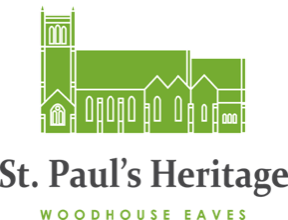
St Paul's Church Clock
by Maria Jansen

St Paul’s has undergone many alterations over the years, including the installation of the clock in 1904 when the tower was raised and new bells were fitted in memory of Queen Victoria.
However, there has always been a mystery surrounding the Church Clock or ‘Village Clock’. Early woodcut sketches and post cards depict the church with no clock in place but a recently discovered report from Smiths of Derby, who undertook a survey prior to the fitting of the new clock states: ‘the old clock is a very poor thing and we would certainly not advise Chimes to be attached’
An image from 1902 also shows a clock in situ, confirming that there had definitely been a clock prior to 1904 but when it was fitted remains a mystery. It was sold for £4 10 shillings.

A clock face and hands can be seen on this photograph from 1902
(Reproduced by permission of British Geological Survey EA18/030)

The face of the new clock
The new clock was made and installed by Smiths of Derby in 1904 at a cost of £139 10 shillings – a clock made to the same specification by Smiths in 2017 would be approximately £150,000.00 + VAT at 20%!
But who paid for the clock? Amongst the newly discovered documents, a ‘Subscriptions List towards the Woodhouse Eaves Bells and Clock Fund’ was found which lists individual benefactors who subscribed over ten shillings towards the cost of the bells and clock.
The second highest amount, £139 10 shillings, was given by the Rev A.J. Hiley, vicar of St Paul’s, which covered the cost of the clock and proves that he paid for it. A plaque in the church commemorates his donation.
The new clock originally had to be wound by hand but in 1998 an electric winding system was installed at the cost of £5,000, paid for by an unknown benefactor in the village.

Subscription list showing Rev Hiley's donation

Plaque commemorating Rev Hiley's donation

The workings of St Paul's clock
You can see the workings of the clock in the glass panelled cupboard in the porch!